What is Social Media Listening — and Why It Matters
If you’re looking to learn the basics of social media marketing, take a look at our article on how to create a social media marketing plan as well as the numerous articles available in our blog.
What is Social Media Listening?
Social media listening is a powerful technique that helps businesses to evaluate their online brand reputations by analysing customer interactions on social media platforms.
Through social media listening, you can take concrete steps to improve the performance of your social media marketing campaigns and enhance your customer experience.
Did you know that businesses spend anywhere from $1,000 to $20,000 per month on social media marketing? With such a significant monthly investment, it only makes sense for them to analyse, evaluate and measure their online success. This is where techniques like social media listening and social media monitoring come in.
Through social media listening, companies can also get a better idea of how their customers feel about their brands.
Let’s look at the example of a confectionery shop that frequently posts pictures and shares stories of its cookies, cakes and other sweet treats on its Instagram account. Followers and customers may regularly like and occasionally comment on the posts or interact with the stories. It’s nice to be appreciated, but the owner also wants to know where he can improve.
With an effective social listening process, the owner can get valuable insights on the less-discussed products on social channels. These may be posted or reviewed on third party forums or social media channels that he isn’t aware of. With the right social listening and monitoring tools, he can glean these insights, directly seek customer feedback, and improve his bakery products.
In short, social media listening helps businesses to create a better customer experience by listening to and analysing what customers are talking about them on social channels beyond their own.
The two-step process of social media listening:
Wish to implement a social media listening strategy for your business? Follow these two steps.
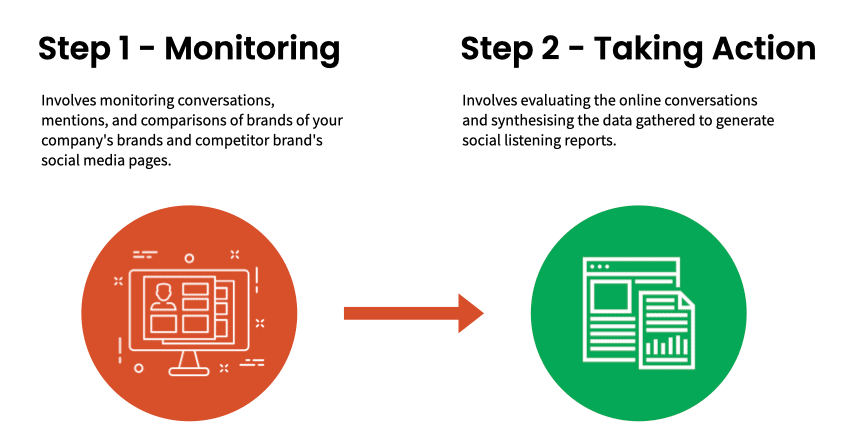
Step 1 – Monitoring
The first step in social media listening involves monitoring conversations, mentions, and comparisons of brands of your company’s brands and competitor brand’s social media pages. You should also monitor and track brand mentions and interactions on other channels like online forums.
You can track such conversations or discussions by putting your business-related keywords on search engines (e.g. Google Alerts) and to reach pages that have mentioned your brand.
You may also wish to go to social networks like Facebook, Instagram, Twitter, LinkedIn, or TikTok, and key in your brand names or hashtags into the search bar on these platforms. Once you’ve done so, you’ll be able to see which accounts or pages have mentioned your brand.
Step 2 – Taking action
The second step of the social listening process involves evaluating the online conversations and synthesising the data gathered to generate social listening reports. From these reports, you can then move on to develop actionable steps that your company can take.
Here are some of the most common actions that you can take based on the social listening report:
- If the social listening report points to a lacuna in a specific feature of the product, which didn’t work the way it was touted to be, you can readily work on improvising the product.
- If an employee in your organisation has been flagged out for being rude, you can counsel that employee and take corrective action before it’s too late.
- If online buzz suggests that customers do not see value for money in your products, you can adjust the pricing or introduce promotions.
Beyond addressing product or service flaws, you should also interact with the customer who provided the negative feedback and offer to make restitution. Doing so can make all the difference in service recovery, and you may even turn an angry customer into an ardent brand advocate!
Here are some examples of brands which have taken action.
1 . Tylenol

Discussion on forums about headache caused due to knitting
Tylenol, the painkiller manufacturer, wished to find out what the common triggers of migraine headaches were for their customers (and potential customers).
Through social listening techniques, they discovered that many people complained about headaches that stemmed from eye-straining activities like knitting. There were numerous mentions and discussions on headaches due to the pressure that knitting puts on the eyes in knitting-based websites and forums.
Using this insight, Tylenol adjusted its digital marketing techniques to reach out to the knitting community and tap a new customer base.
2. BMW

Snapshot of discussions on forum about BMW’s laserlight
BMW used social listening techniques to track consumer interest and enthusiasm in the new features added to the automobile.
From their social listening efforts, they discerned that a lot of discussion was generated around the newly developed laser-guided headlights. Apparently, car drivers were huge fans of the latest version of the laser-guided headlights.
Conversely, data from previous years revealed that the previous versions of LED-powered headlights weren’t as well received. This led them to discontinue those vehicle models. Without an effective social listening strategy or the right tools, BMW would have missed the insight that their customers preferred the features in the latest version of laser headlights.
3. Samsung
Samsung wished to learn consumer trends prior to the launch of their latest products. They sought answers to questions like these:
- Which of our new phones produced the most buzz?
- What effect does the debut of each product have on the volume of conversation?
- Which devices generated the most or least dialogue?
The company monitored these global launches in real-time through social listening tools. They learned how effective their launch events were, and what purchasers thought of the products that were rolled out at each event.
They also gained useful insights on potential areas of business growth as well as actions needed to improve their customer service by tracking online conversations and key trends.
Samsung compared these insights to previous product launches and improved how future product launch events were orchestrated.
Social media listening vs social media monitoring
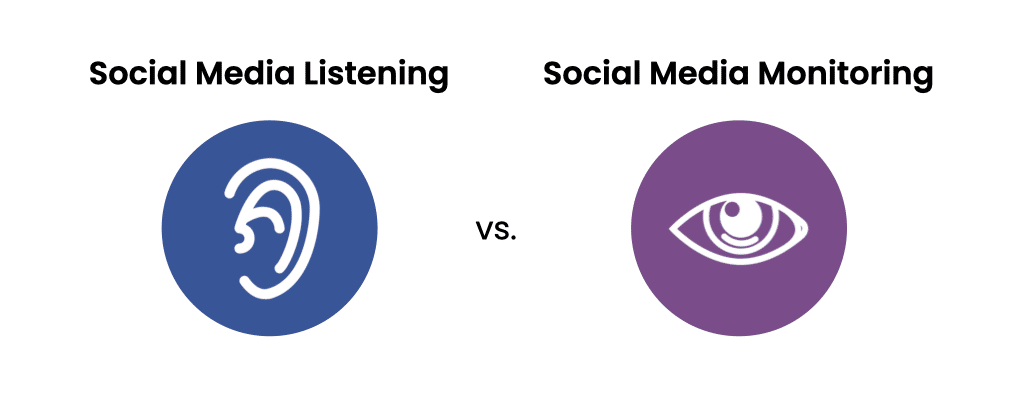
Is social media listening comparable to social media monitoring? What is the difference between the two?
Social media monitoring normally refers to the process of searching and collecting data, while social media listening involves analyzing the data, defining a strategy, and taking action.
Comparatively speaking, social media listening is a higher-order technique that builds on the data collected during the monitoring stage to help businesses refine their future strategy.
Here are some of the fundamental differences between social media monitoring and social media listening:
Social monitoring is about metrics; social listening analyzes sentiments
Social media monitoring looks at metrics like engagement rate and the number of mentions; social listening analyzes the mood behind the data. The latter helps businesses understand how customers feel about them compared to their competitors.
Thus, social media listening isn’t just about counting the number of times a brand gets mentioned or tagged. Rather, it’s about getting deeper insights into the customer’s feelings and creating a more engaging and satisfying experience.
Social monitoring works at the micro-level; social listening works at the macro level
Social media monitoring works on a micro-level. Thus, they are useful for day to day customer-service type of interactions. Companies may receive messages, queries, likes, shares and reply to incoming questions, complaints, and comments on social media platforms.
On the other hand, the purpose of social media listening is to offer a macro-level insight into the general feeling and opinion of customers about your brand. These insights help you to learn what customers want from your brand and take appropriate actions to match their expectations.
Social media monitoring is reactive; social media listening is proactive
Social media monitoring is normally reactive. It pertains to managing comments and reactions received on various platforms after they have occurred.
When a customer initiates contact with your company, your social media representative reacts to solve his problem or answer a question. It’s a fundamental social approach to have but is only limited to interactions that start from the customer’s side.
On the other hand, with social listening, you can proactively dig out comments or reviews and analyse them to help your brand in the following ways:
- Coming across conversations that point towards a possible problem with your brand triggering a negative image in the long run
- Uncovering the latest trends in the business
- Knowing what customers are talking about your competitor
- Hearing the voice of the customer
Based on the insights from these interactions, companies can then design a long-term strategy to outsmart the competition and be on top of the customer’s mind.
Social media monitoring is manual; social media listening is automated
Social media monitoring activities like recording the number of likes, re-tweets, shares, negative and positive comments do not require a high level of automation. They are usually done manually or using social media monitoring tools such as the ones listed later in this article.
On the other hand, social listening is heavily based on analytics to generate insights into your customers’ feelings and opinions. It may involve the use of Artificial Intelligence (incorporates AI) or other automated social listening tools to help determine intent and predict cases that may need to be escalated for immediate action.
Doing so helps brands to nip the complaints from dissatisfied customers in the bud and avoid a full-blown online crisis that can occur as negative remarks continue staying long on social channels.
Why does social listening matter?
Social listening matters because it helps you to tap vital customer insights based on the conversations about your brand on various social media channels as well as on forums and websites. In the absence of social listening, brands may miss invaluable feedback that helps them take constructive action to achieve long-term success.
Let us suppose that an online grocery store spots comments on forums that talk about a faster delivery time offered by the competitor. This is a clear indication that an inefficient delivery process can be one of the reasons for your customer to switch to a competitor.
Moreover, through social media channels, customers frequently communicate about what they want from the brand. Thus, using the insights provided by the social media listening process, brands can do the following:
- Connect with customers
- Manage/pre-empt a crisis
- Track competitors
- Find customer pain points
- Discover potential leads
- Identify social media influencers
- Gain insight into customer preferences
Social Media Listening Strategy
Businesses must have a proper social listening strategy to channelize their social listening efforts towards the areas that matter most. In developing your own, do take note of the following steps.
Things to consider when developing a social listening strategy:
1) Goal setting
The first and most important thing you need to do is to define the goals that your business wants to achieve from the social listening process. Are you looking out for feedback from influencers who use your products? Or perhaps evaluate how your brand compares to a competitor’s offering? It is crucial to decide the main objective of the social listening process in order to measure its effectiveness.
Read our insightful blog on Top 12 Social Media KPIs to use in your marketing campaign.
2) Identifying keywords
Social listening relies on tools to generate reports. The tools are configured with relevant keywords, which form the basis of these reports. Hence, it is essential to identify the right keywords which help in generating reports that offer valuable insights.
3) Taking corrective action
The most important part of the social listening strategy is to implement corrective steps based on the results generated through the social listening process. For example, if the goal of your social listening exercise was to gauge your company’s online reputation, there should be an action plan, with definite steps to work on modifying the image based on the report.
Top free social media listening tools:
Need help to improve your social listening? Consider these tools.
- Brand Mentions: Brand Mentions is a web-based application that gives instant access to online referrals to your brand mentions across social, news, blogs, videos and more. Product reviews, social media posts, blog entries, and news articles all contain these references. Brand mentions directly impact a brand’s reputation, it’s critical to keep track of them and respond to unfavourable ones immediately.
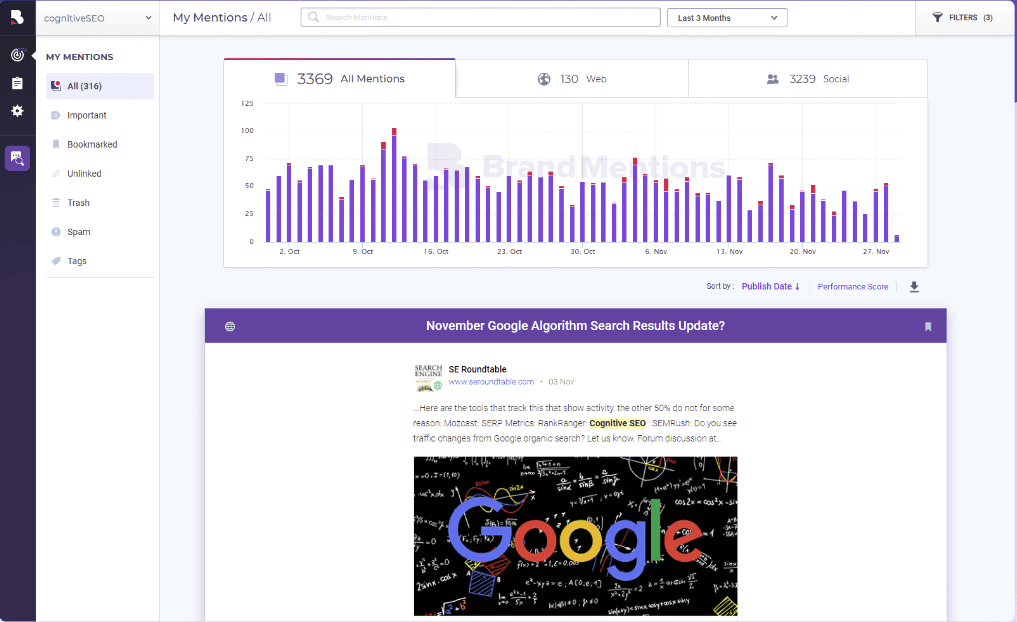
Brand Mentions dashboard. Source: Brand Mentions
- BoardReader: BoardReader is a web-based application that collects data primarily from online forums and discussions on a variety of social media platforms. It’s an effective social media listening tool that few people know about, and the best part is that it’s completely free.
- TweetDeck: TweetDeck is a Twitter account management program with a social media dashboard. It allows users to keep an eye on live streams from all over the Internet and allows you to respond quickly to any negative brand mentions.
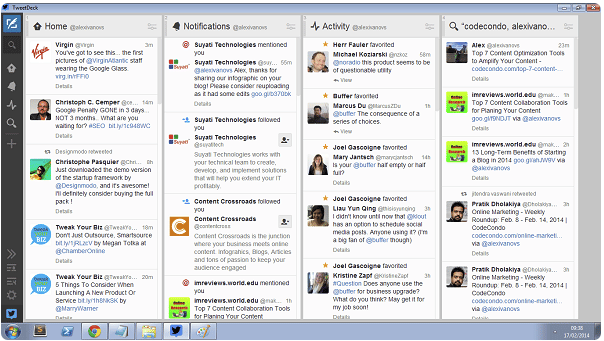
Tweetdeck dashboard – Source: Codecondo
- Followerwonk: Followerwonk is a Twitter analytics application that helps users explore and expand their social network by allowing them to identify, evaluate, and optimize for social growth. Followerwonk visualizes data for users and followers during their most active moments, making it simple to make intelligent business decisions at a glance.
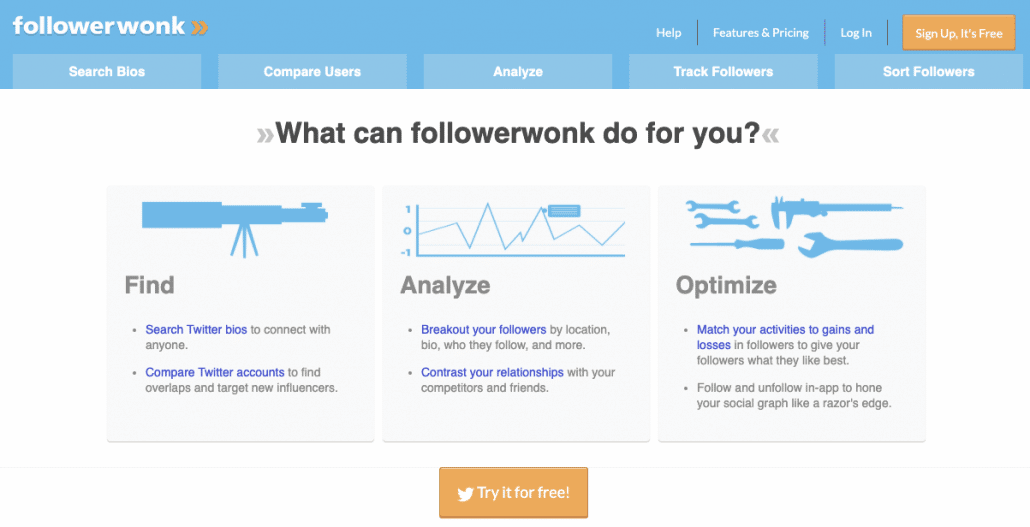
Follower Wonk. Source: Followerwonk
- Google News: Use Google News to look for a brand name, keywords, and the competition through its wide network of sources from all over the world.
- Google Trends: Google Trends is an excellent tool for learning about seasonal trends pertaining to specific products or domains. You can even utilize it to track competitor’s movement.
Read more on tools for social listening/ social monitoring in this article.
How to Develop a Social Listening Spreadsheet?
To create a social listening spreadsheet, keep track of your brand’s interactions and comments across various social media platforms and uncover consumer and competitor information. Doing so helps you to systematically manage your social media marketing efforts and determine where potential opportunities (and threats) may arise.
Here’s a list of things to include in a social listening spreadsheet:
- Social media channel
- Title of post
- Day/Time/Date of Post
- Topic
- Reach of post
- Shares
- Comments
- Interactions on post
- Any qualitative insights (e.g. positive, negative or neutral)
Check out this free social media listening template: https://www.smartsheet.com/social-media-templates
Conclusion
Social media listening offers insights about a business as well as its position vis-a-vis the competitors in the industry. Such insights help you to sharpen your future campaigns, allowing you to launch social media marketing campaigns that resonate better with your customers and achieve better ROI.
The social listening tool helps social media marketing strategy leap to the next stage and enable the business to implement corrective actions to control a crisis and achieve sustainable growth over a period of time.
New to social media and want to plan a social media strategy for business? Check our two-day WSQ Certification Course on Social Media Marketing that offers hands-on training in setting up your social media marketing plan and teaches you how to track results and take actions. Please also feel free to browse our selection of digital marketing courses held in-person in Singapore or online as well.